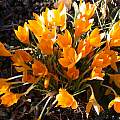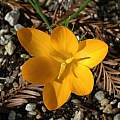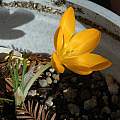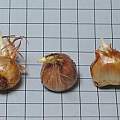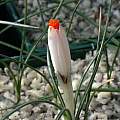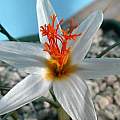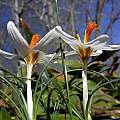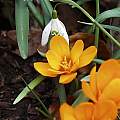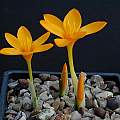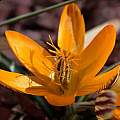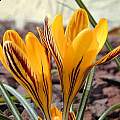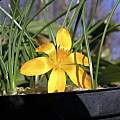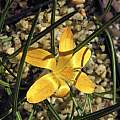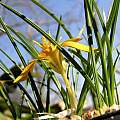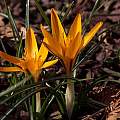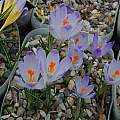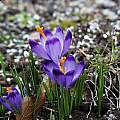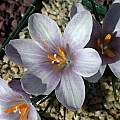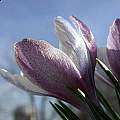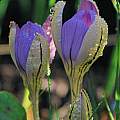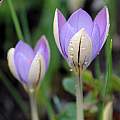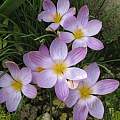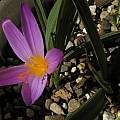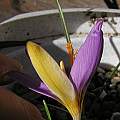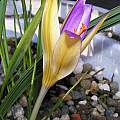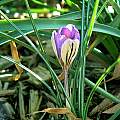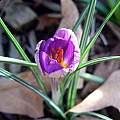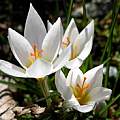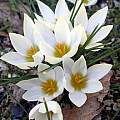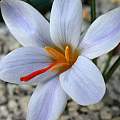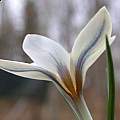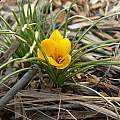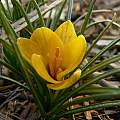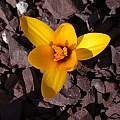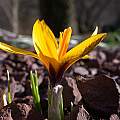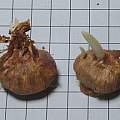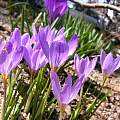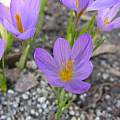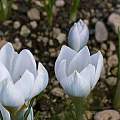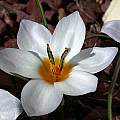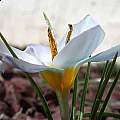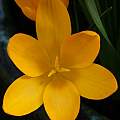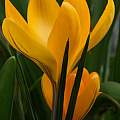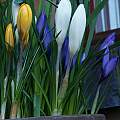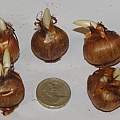Crocus is a genus in the Iridaceae family that is widespread; it is found in Europe, North Africa and in Asia. The standard reference on the genus was Brian Mathew, The Crocus written in 1982, but at least half a dozen taxa, including new species, have been described since its publication. In 2010 Jānis Rukšāns published the book Crocuses: A Complete Guide to the Genus that includes descriptions of species and cultivation information. This PBS wiki page describes Spring Blooming Crocus species f-l.
Crocus index - Fall Blooming crocus a-h - Fall Blooming crocus i-o - Fall Blooming crocus p-z - Spring Blooming crocus a-b - Spring Blooming crocus c-e - Spring Blooming crocus m-s - Spring Blooming crocus t-z
Crocus flavus Weston (syn. Crocus aureus, Crocus maesiacus) is native to the Balkans and Western Turkey where it is found in scrubland and woods. It has up to eight narrow erect leaves and up to four yellow to orange flowers with a three-lobed stigma which does not overtop the stamens. Height range: 20-30 cm. Photo 1 by Jane McGary of the wild, or typical, form of one of the parents of the commonly grown early spring yellow crocus known as Crocus 'Golden Yellow' (syn. 'Dutch Yellow', 'Yellow Mammoth'). The other parent of the garden form is thought to have been Crocus angustifolius. Both Crocus flavus and 'Golden Yellow' are excellent garden plants in temperate climates, flowering in late winter. Photo 2-3 from Mary Sue Ittner. The last photo of commercial corms of ssp. flavus on a 10 mm grid by David Pilling.
Crocus fleischeri J.Gay comes from western Turkey, near Izmir. Mathew recommends that it be given "a hot sunny situation with good drainage." Bowles said the stigmata of these flowers are "of such a bright color that they can be be seen through the white segments of a closed flower, and remind me of the yolk seen through the shell of a woodpecker's egg." Height: about 7 cm. Photos by John Lonsdale.
Crocus gargaricus Herb. (and friend) - is from Turkey where it grows on grassy slopes. It is a spring bloomer with golden flowers that in its native habitat blooms as the leaves are appearing. Height: 5 cm. Photo by Arnold Trachtenberg.
Crocus gargaricus ssp. gargaricus This subspecies does not produce stolons. Photographed by Tony Goode.
Crocus graveolens Boiss. & Reut. ranges from southern Turkey to Lebanon. Mathew reports that they often have a strong unpleasant smell. Bowles was more outspoken: "C. graveolens would however be recognizable anywhere...by the abominable odor which is perceptible, even at a distance of some yards, when its small flowers are open on a sunny day." Height range: 7-8 cm. Photos by John Lonsdale.
Crocus heuffelianus Herb. was for a while included in Crocus vernus but has been reinstalled as a valid species as of January 2023. Height: to about 35 cm. The first photo below, by Tony Goode, shows a form from the Balkans and populations further east with large rounded flowers with dark purple tips. The second photo shows the plant from Ruksans named Crocus heuffelianus "Dark Eyes", photographed by Arnold Trachtenberg. The next two photos, by John Lonsdale, show another Balkan form, this one previously known as Crocus scepusiensis var leucostigma, now considered to be C. heuffelianus subsp. scepusiensis.
Crocus imperati Ten. is a large-flowered species endemic to Italy, found on the west side in the regions of Lazio and Campania (approx. from Rome to Naples). Flowers are violet on the inside and biscuit-colored on the outside with violet stripes. Height: 10 cm.
Crocus imperati ssp. imperati differs from the other subspecies by having two bracts sheathing the tube instead of one. Planted in the ground in Northern California it is a reliable bloomer, coming back each year, but blooming in December or January, our wettest months when the flowers are often destroyed by the rain. Photos by Mary Sue Ittner showing the different inner and outer tepals colouration and Angelo Porcelli showing fully open flowers photographed from the front.
Crocus imperati ssp. suaveolens (Bertol.) B.Mathew is a species from Italy that is rich violet on the inside and yellow to buff colored on the outside with violet striping on the back. It is distinguished from the other subspecies by having only one bract. Blooming for the first time from seed in January 2004 and photographed by Bob Rutemoeller. The second photograph shows this flower as having one tepal with purple on the outside. Another flower had several purple tepals on the outside as well as the usual buff colored ones. The last photo by Mary Sue Ittner taken late afternoon as the flower is closing shows the bract on the bottom of the photo.
Crocus imperati 'Jager' I don't know much about this plant other than it is doing very well in my North Georgia, USA home. It blooms by late January and is more robust here than other "super early" crocuses. Photos by Steve Burger taken January 2007.
Crocus × jessoppiae Bowles is possibly a hybrid. In A Handbook of Crocus and Colchicum for Gardeners E.A. Bowles says that it "appeared in some seedlings and offsets I gave to my neighbor the late Miss Euphemia Jessopp." The style is divided into 3. The flowers, white as milk, have a throat full of sunshine and a blue blotch at the base of the outer segments. They are plentiful, long-lasting, apparently storm-proof and bloom in March-April. Brian Mathew suggested in The Crocus that one parent is Crocus reticulatus. This plant grows to 7-10 cm (3-4") and is hardy to Zone 6. Text and photos from Paige Woodward.
Crocus kerndorffiorum Pasche comes from the Taurus Mountains in southern Turkey. Tony Goode says it needs to be grown in a cool situation, with a cool moderately dry summer rest. Height range: 10-20 cm. Photos by John Lonsdale.
Crocus korolkowii Maw & Regel grows in the wild in an area stretching from Pakistan to Russia. It is reportedly very resistant to cold. It blooms throughout January here in my North Georgia, USA home. Often this plant starts before Crocus laevigatus is finished - providing perfect overlap. I have it growing in both very well drained soils and moister soils (although never approaching wet) and it has performed with mixed results in both locations. Height range: 10-20 cm. Photos 1 and 2 by Steve Burger, photos 3 and 4 by John Lonsdale; photo 4 is of a selection named 'Lucky Number'. Photo 5 of corms on a 10 mm grid by David Pilling.
Crocus kosaninii Pulevic is found in Southern Serbia in lowland oak, juniper and hawthorn forests. It is a member of the C. vernus complex and characterized by a yellow throat. Height range: 10-20 cm. Photos by Arnold Trachtenberg.
Crocus leichtlinii (Dewer) Bowles is native to Turkey in mountain areas that are very cold in winter and very hot and dry in summer. In cultivation it typically flowers very early (shown here in January in northwestern Oregon) and should be kept quite dry in summer (here, in a bulb frame, plunged in sand). It is notable for its pure blue color, best seen when the flowers are not fully open since the blue is mostly on the reverse of the tepals. The plants in the first photo were grown from seed obtained from the Goteborg Botanic Garden, a KPPZ collection, and are about 8 years old. Height range: 10-20 cm. First photo by Jane McGary, next two by John Lonsdale.
Crocus × luteus Lam. 'Yellow Mammoth' is a hybrid of Crocus flavus and Crocus angustifolius. Height range: 10-15 cm. Photographs by David Pilling. In photo 3 the 'Dutch' crocuses 'Joan of Arc' and 'Grand Maitre' are also visible. The coin in photo 4 is about an inch in diameter.
Crocus index - Fall Blooming crocus a-h - Fall Blooming crocus i-o - Fall Blooming crocus p-z - Spring Blooming crocus a-b - Spring Blooming crocus c-e - Spring Blooming crocus m-s - Spring Blooming crocus t-z
